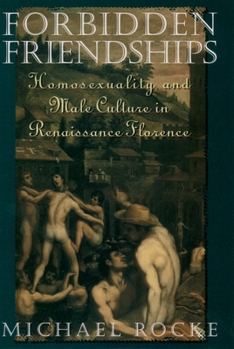Forbidden Friendships: Homosexuality and Male Culture in Renaissance Florence
Select Format
Select Condition 
Book Overview
"This is a superb work of scholarship, impossible to overpraise.... It marks a milestone in the 20-year rise of gay and lesbian studies."--Martin Duberman, The Advocate The men of Renaissance Florence were so renowned for sodomy that "Florenzer" in German meant "sodomite." In the late fifteenth century, as many as one in two Florentine men had come to the attention of the authorities for sodomy by the time they were thirty. In 1432 The Office of the Night was created specifically to police sodomy in Florence. Indeed, nearly all Florentine males probably had some kind of same-sex experience as a part of their "normal" sexual life. Seventy years of denunciations, interrogations, and sentencings left an extraordinarily detailed record, which author Michael Rocke has used in his vivid depiction of this vibrant sexual culture in a world where these same-sex acts were not the deviant transgressions of a small minority, but an integral part of a normal masculine identity. Rocke roots this sexual activity in the broader context of Renaissance Florence, with its social networks of families, juvenile gangs, neighbors, patronage, workshops, and confraternities, and its busy political life from the early years of the Republic through the period of Lorenzo de' Medici, Savonarola, and the beginning of Medici princely rule. His richly detailed book paints a fascinating picture of Renaissance Florence and calls into question our modern conceptions of gender and sexual identity.
Format:Paperback
Language:English
ISBN:0195122925
ISBN13:9780195122923
Release Date:March 1998
Publisher:Oxford University Press
Length:384 Pages
Weight:1.44 lbs.
Dimensions:1.0" x 6.1" x 9.2"
Customer Reviews
2 ratings
Eye opening scholarship
Published by Thriftbooks.com User , 25 years ago
Michael Rocke's tome on male culture and sexuality in Renaissance Florence is a tremendous work that provides exceptional insight into male sexuality. After reading this, only the most obdurate student of gay life and history could fail to attain a more significant understanding of the present-day forces that seek to quash gays and their efforts for equality under the law. Rocke's careful research of 15th- and 16th-century documents unequivocably shows that if not most, quite nearly a mjority of Florentine males at the time had sex at least once with another male. The significance of such a finding should not be missed.Present day gays roll their eyes whenever they encounter the supposition that a person can "be made gay" or "converted" to being gay because of the firm belief that one's sexuality is predominantly innate. But after reading Rocke's book, one can't help but see how males that today would undoubtedly be identified as heterosexual had freely enjoyed sex with other males. The significance of this, however, should not be interpreted to mean that one's sexuality is entirely a choice. It does, however, provide an understanding of why some homophobes fear gays.The Dominican cleric Savonarola's rhetoric in the war he waged against sodomy in Florence provides a historical background as well for understanding the position of today's Religious Right and its stance against gays. Savonarola figures heavily in Rocke's book and the author provides wonderful detail on the political machinations of the time, a politic that essentially recognized the need to publicly take a stand against sodomy, but in practicality often lacked the nerve to do what was necessary to rid the city of "this vice."Anyone interested in the history surrounding gays and homosexuality is strongly urged to add this title to their list.
A Masterpiece of Scholarship in Its Field!
Published by Thriftbooks.com User , 28 years ago
I won't hide my praise; this book is a masterpiece in the study of male-male sexuality in the Renaissance. Finally, due to some historically fortuitous and unfortunately rare records, some one has provided firm demographic evidence on the phenomenon in one major city. These demographics settle a number of thorny questions that have plagued the field since its inception. Over two-thirds the male population of Renaissance Florence was involved in pederasty. We are not dealing with a small but relatively free homosexual minority; instead, the average Florentine Renaissance male, regardless of sexual orientation, engaged in some form of sex with males. This book is essential not only to those interested in the Renaissance but also to all interested in ancient (Western) history. Those interested in ancient Greece and Rome in particular will be fascinated to learn that Greek practices are still very much alive in Renaissance Italy, over two-thousand years later. The book casts serious doubt on the notion that a small, aritocratic minority practiced pederasty in Classical Antiquity. Rocke firmly establishes that male pederastic sex and relationships in Renaissance Florence were embedded in the broader contexts of male culture and sociality, class, retribution, and politics. His book is an additional verification of the anthropological theory that most pre-industrial societies accepted male pederasty as a valid expression of a man's sexual desires, though only ancient Greece and Rome seem to have so publicly lauded the practice in their art, literature, and philosophy.






